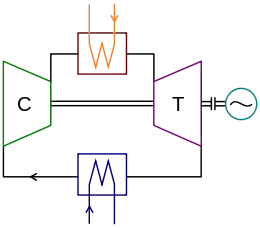
C compressor and T turbine assembly
w high-temperature heat exchanger
ʍ low-temperature heat exchanger
~ mechanical load, e.g. electric generator
A closed-cycle gas turbine is a turbine that uses a gas (e.g. air, nitrogen, helium, argon,[1][2] etc.) for the working fluid as part of a closed thermodynamic system. Heat is supplied from an external source.[3] Such recirculating turbines follow the Brayton cycle.[4][5]
Background
The initial patent for a closed-cycle gas turbine (CCGT) was issued in 1935 and they were first used commercially in 1939.[3] Seven CCGT units were built in Switzerland and Germany by 1978.[2] Historically, CCGTs found most use as external combustion engines "with fuels such as bituminous coal, brown coal and blast furnace gas" but were superseded by open cycle gas turbines using cleaner-burning fuels (e.g. "gas or light oil"), especially in highly efficient combined cycle systems.[3] Air-based CCGT systems have demonstrated very high availability and reliability.[6] The most notable helium-based system thus far was Oberhausen 2, a 50 megawatt cogeneration plant that operated from 1975 to 1987 in Germany.[7] Compared to Europe where the technology was originally developed, CCGT is not well known in the US.[8]
Nuclear power
Gas-cooled reactors powering helium-based closed-cycle gas turbines were suggested in 1945.[8] The experimental ML-1 nuclear reactor in the early-1960s used a nitrogen-based CCGT operating at 0.9 MPa.[9] The cancelled pebble bed modular reactor was intended to be coupled with a helium CCGT.[10] Future nuclear (Generation IV reactors) may employ CCGT for power generation,[3] e.g. Flibe Energy intends to produce a liquid fluoride thorium reactor coupled with a CCGT.[11]
Development
Closed-cycle gas turbines hold promise for use with future high temperature solar power[3] and fusion power[2] generation.
They have also been proposed as a technology for use in long-term space exploration.[12]
Supercritical carbon dioxide closed-cycle gas turbines are under development; "The main advantage of the supercritical CO2 cycle is comparable efficiency with the helium Brayton cycle at significantly lower temperature" (550 °C vs. 850 °C), but with the disadvantage of higher pressure (20 MPa vs. 8 MPa).[13] Sandia National Laboratories has a goal of developing a 10 MWe supercritical CO2 demonstration CCGT by 2019.[14]
See also
References
- ↑ Nitrogen or Air Versus Helium for Nuclear Closed Cycle Gas Turbines | Atomic Insights
- 1 2 3 "AN ASSESSMENT OF THE BRAYTON CYCLE FOR HIGH PERFORMANCE POWER PLANTS" (PDF). Archived from the original (PDF) on 29 June 2010. Retrieved 10 June 2012.
- 1 2 3 4 5 Frutschi, Hans Ulrich (2005). Closed-Cycle Gas Turbines. ASME Press. ISBN 0-7918-0226-4. Archived from the original on 21 December 2011. Retrieved 7 December 2011. Note: front matter (including preface and introduction; PDF link) is open access.
- ↑ Thermodynamics and Propulsion: Brayton Cycle
- ↑ A REVIEW OF HELIUM GAS TURBINE TECHNOLOGY FOR HIGH-TEMPERATURE GAS-COOLED REACTORS Archived 26 April 2012 at the Wayback Machine
- ↑ Keller, C. (1978). "Forty years of experience on closed-cycle gas turbines". Annals of Nuclear Energy. 5 (8–10): 405–422. doi:10.1016/0306-4549(78)90021-X.
- ↑ "Nuclear Power: Small modular reactors". Power Engineering. 7 June 2012. Retrieved 7 June 2012.
- 1 2 McDonald, C. F. (2012). "Helium turbomachinery operating experience from gas turbine power plants and test facilities". Applied Thermal Engineering. 44: 108–181. doi:10.1016/j.applthermaleng.2012.02.041.
- ↑ "ML-1 Mobile Power System: Reactor in a Box | Atomic Insights". Archived from the original on 22 July 2012. Retrieved 6 June 2012.
- ↑ IAEA Technical Committee Meeting on "Gas Turbine Power Conversion Systems for Modular HTGRs", held from 14–16 November 2000 in Palo Alto, California. International Atomic Energy Agency, Vienna (Austria). Technical Working Group on Gas-Cooled Reactors. IAEA-TECDOC--1238, pp:102-113
- ↑ Introduction to Flibe Energy: YouTube Video (~20 min) and PDF Archived 5 April 2012 at the Wayback Machine of slides used
- ↑ Introduction to Gas Turbines for Non-Engineers (see page 5)
- ↑ V. Dostal, M.J. Driscoll, P. Hejzlar, "Archived copy" (PDF). Archived from the original (PDF) on 27 December 2010. Retrieved 7 December 2011.
{{cite web}}: CS1 maint: archived copy as title (link) MIT-ANP-Series, MIT-ANP-TR-100 (2004) - ↑ Sandia National Laboratories: Supercritical CO2-Brayton Cycle
External links
- US Patent 5309492 "Control for a closed cycle gas turbine system"
- Industrial Closed-cycle Gas Turbines for Conventional and Nuclear Fuel (1967)
- Brayton Lab on YouTube (at Sandia National Laboratories, 2014)
- "Aviation Jet Oils"